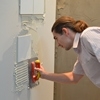Linear thermal expansion
Linear thermal expansion is expressed by dimensional changes in any material, including ceramics, due to changes in temperature. Almost all known materials expand as temperature increases and contract as temperature decreases. The temperature coefficient of linear expansion α for ceramic tiles is calculated with an accuracy of 0.1•10 -6 °C -1 using the formula:
α = dL/(L 0 •dT), where
L 0 – length of the tested sample at room temperature;
dL is the linear expansion of the test sample during the period of temperature change from room temperature to 100 °C;
dT – temperature increase.
The method for determining the temperature coefficient of linear expansion is given in the EN ISO 10545-8:1996 , IDT standard. The coefficient of thermal expansion for floor and wall ceramic tiles varies from 4.1•10 -6 °C -1 to 8.1•10 -6 °C -1 . This means that elongation ranges from 4 to 8 thousandths of a millimeter per meter of ceramic tile and per degree rise in temperature. It is necessary to take into account this property of the tile in relation to other materials of the facing structure.
Humidity expansion (swelling)
Moisture expansion refers to the expansion of the tile due to the absorption of moisture. The consequences of such swelling are similar to the expansion of tiles due to an increase in temperature (linear thermal expansion) and are due to the porous structure of the material. Testing of this indicator is necessary for tiles with a water absorption value of more than 6% (in particular, tiles from groups II and III). Moisture expansion is calculated in millimeters per meter using the following formula:
(dL/L) • 1000, where
dL – difference between two average lengths in millimeters;
L is the average initial length of the test sample in millimeters.
The percentage expansion of moisture can be calculated using the following formula:
(dL/L) • 100.
The method for determining moisture expansion is given in the EN ISO 10545-10:1997 , IDT standard.
There are 3 Comments
Moisture expansion of ceramic tiles
Most glazed and unglazed ceramic tiles and slabs have slight natural moisture expansion, which can be ignored, but does not cause problems if the technology for laying tiles and slabs is followed.
However, if the laying technology is violated, as well as in certain climatic conditions, moisture expansion can cause problems, primarily where ceramic tiles and slabs are laid on concrete that has not reached the required age. In these cases, the upper limit of moisture expansion of ceramic tiles and slabs is recommended to be 0.06% if the test according to ISO 10545-10 is applied.
- Login to leave comments
Humidity expansion of porcelain stoneware
The moisture expansion of porcelain stoneware, determined according to the EN ISO 10545-10 method, does not on average exceed 0.1 mm/m.
However, if the laying technology is violated, as well as in certain climatic conditions, moisture expansion can cause problems, primarily where ceramic tiles and slabs are laid on concrete that has not reached the required age. In these cases, the upper limit of moisture expansion of ceramic tiles and slabs is recommended to be 0.06% if the test according to ISO 10545-10 is applied.
Thus, the permissible limit for moisture expansion of ceramic tiles should not exceed 0.6 mm/m, which is carried out with a margin for ceramic granite.
- Login to leave comments
Thermal expansion of ceramic tiles
Let's calculate at what temperature change the thermal expansion for ceramic tiles will reach the permissible moisture expansion limit. To do this, we will use the following data.
... the permissible limit of moisture expansion of ceramic tiles should not exceed 0.6 mm/m ...
The coefficient of thermal expansion for floor and wall ceramic tiles varies from 4.1•10 -6 °C -1 to 8.1•10 -6 °C -1 . This means that elongation ranges from 4 to 8 thousandths of a millimeter per meter of ceramic tile and per degree rise in temperature.
Thus, if the temperature rise is 80 °C, then the thermal elongation will be 0.32-0.64 mm/m. The last value is very close to the previously indicated 0.6 mm/m.
- Login to leave comments



